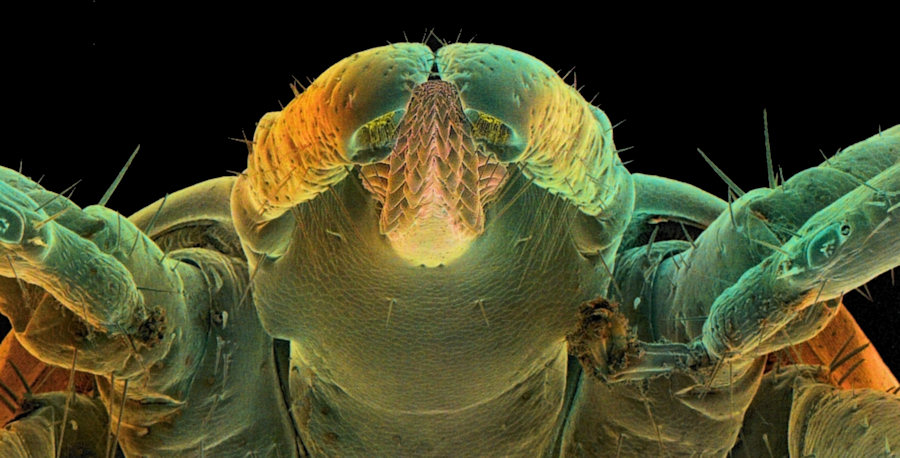
Ixodes is the largest genus of the 14 genera in the Ixodidae family and
contains 243 species.
Ixodes ricinus
Male ticks are 2 mm long. Female ticks 3-4 mm. Ticks prefer humid forests and scrub but can also be found in drier places. Adult males stop feeding but the female need more blood for the development of their eggs. Because ticks do not have eyes they have to rely on their scent and heat sensor. The female waits on grass of a twig with her front legs stretched for a hoist to come by. Her smell sensors are very sensitive for butter acid and ammonia, two
odors mammals and birds excrete.
With the combination of the warmth of the passing bird or mammal she decides to jump on the fur, feathers or clothing. She crawls to a humid place on the skin, starts digging with her saw-like beak through the skin. When settled firmly she spits saliva in the wound to prevent the blood from clotting and start feeding. Feeding lasts one to two weeks. Then the adult female is ready to lay her 2000 to 3000 eggs.
Adult males do not feed anymore in their last life cycle. Their only purpose is to mate with the female. They wait for an large animal to pass by and jump on it hoping to find a female engorged and drinking blood to mate with. When they can not find a female in fall they overwinter and try it next spring.
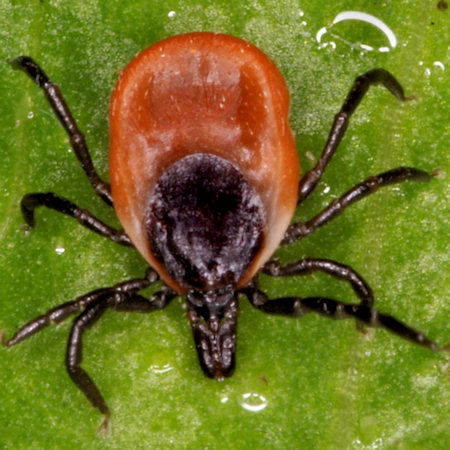
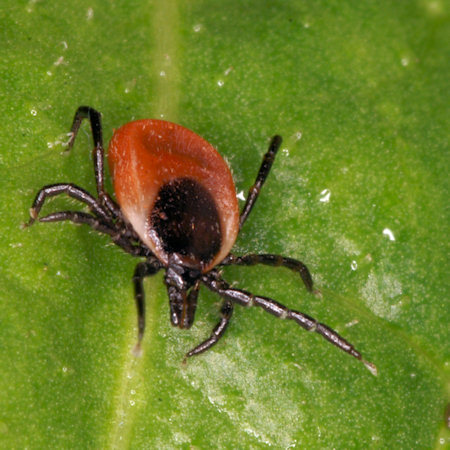

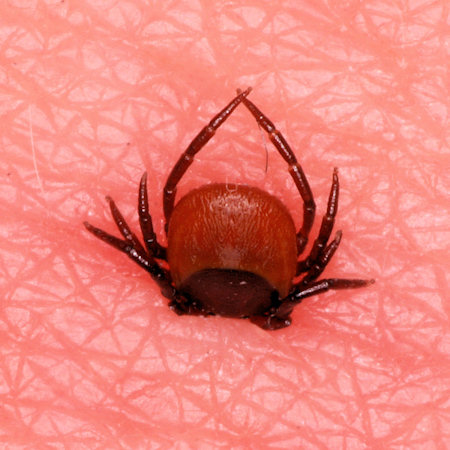
On the picture above the saw-like beak is good to see. Because the tick crawls deep in the skin it has moved up and sideways the entrances to the book lungs.
Ticks can grow significantly in size when sucked full with blood.
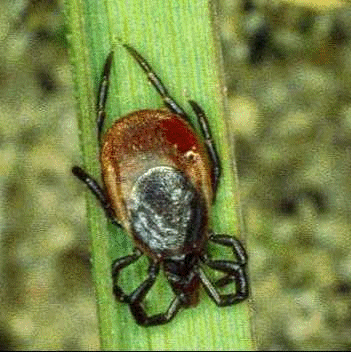


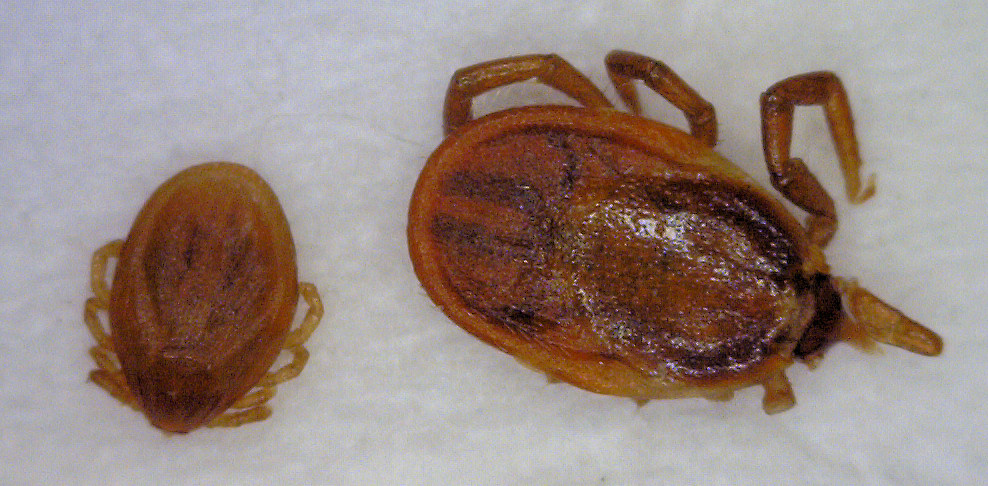
More on ticks
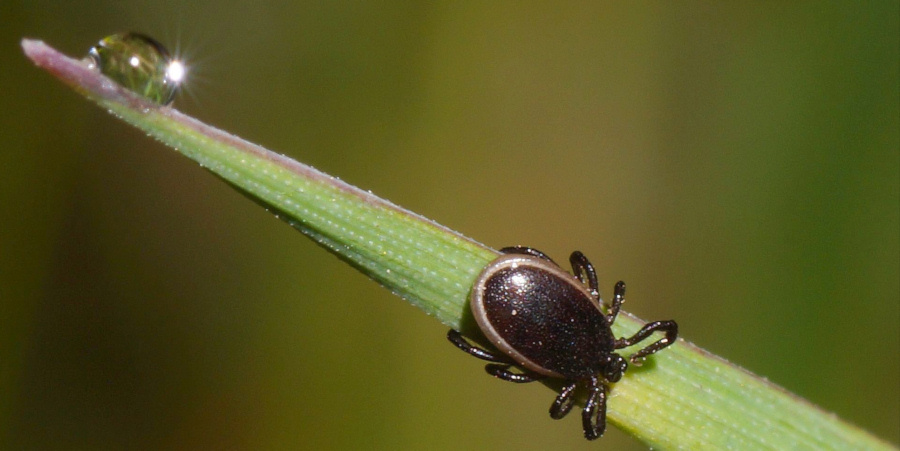
If the tick is infected with spirochetes of the genus Borrelia burgerdorferi, a human can develop Lyme disease also called Lyme borreliosis.
The disease is characterized by a skin rash, forming a red ring after a few weeks, around the bite called erythema migrans followed by arthritis and/or neurological problems.
The disease was first described in 1975 in a study of juvenile arthritis in the town Old Lyme. Many children with juvenile arthritis had been bitten by a tick and developed the typical skin rash. The investigator Burgerdorfer isolated in 1981 Borrelia burgerdorferi from infected patients.
In the US Borrelia burgerdorferi is the only cause of Lyme borreliosis.
In Europe also Borrelia garinii and Borrelia afzelii cause the disease.
In endemic areas in The Netherlands and the USA the incidence can peak to 1 in 1000 inhabitants.
Ixodes pacificus, the Western black-legged tick, is the main vector in Western North America. Ixodes scapularis (deer tick) is the tick that transmits in Eastern North America Borrelia burgerdorferi.
In Europe the main vector is Ixodes ricinus (sheep tick).
In Australia Lyme disease is not transmitted by Australian ticks, until now. Beside Lyme disease ticks can also transmit other infections.
The two year life cycle of a tick is complicated and consists of 4 stages.
It starts with the eggs laid by the mother in spring. This stage is called the
larval stage. To mature the tick need its first blood meal. It chooses small rodents and birds in summer. This is the stage most ticks
acquires the Borrelia bacteria from the already infected hosts. After feeding the
larvae drops from the host and starts to molt to the nymph stage. Normally they overwinter in this stage and take their second blood meal in the spring next year. In this stage Ixodes is able to transmit the Borrelia to humans and other hosts. This is the stage most Borrelia infection in humans occur. After this second meal the tick molts to the adults stage. Then they feed on larger animal like deer. During feeding the female is inseminated by the male. In spring she will lay 2000 -3000 eggs and the cycle starts again.
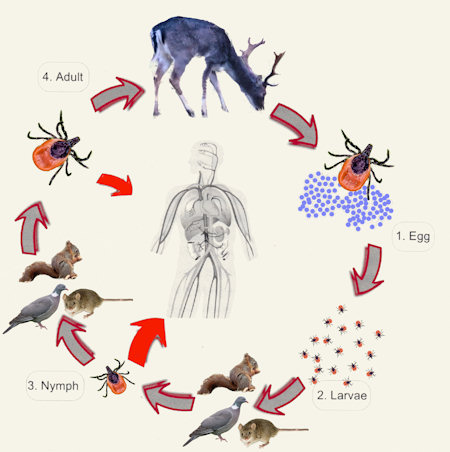
To the body spirochetes are foreign and the body will attack it with its immune system. Many systems are active during infections. When the body has not made antibodies from a previous infection the first defense line are the white blood cells (leucocytes) and the complement system. This complement system is a cascade of protein actions causes the migration of white blood cell to the infection or make a physical hole in the bacterium resulting in its deaths. The coagulation system is also a line of defense because this will close the wound and make the blood coagulate.
But the tick found ways to inhibit these fancy systems.
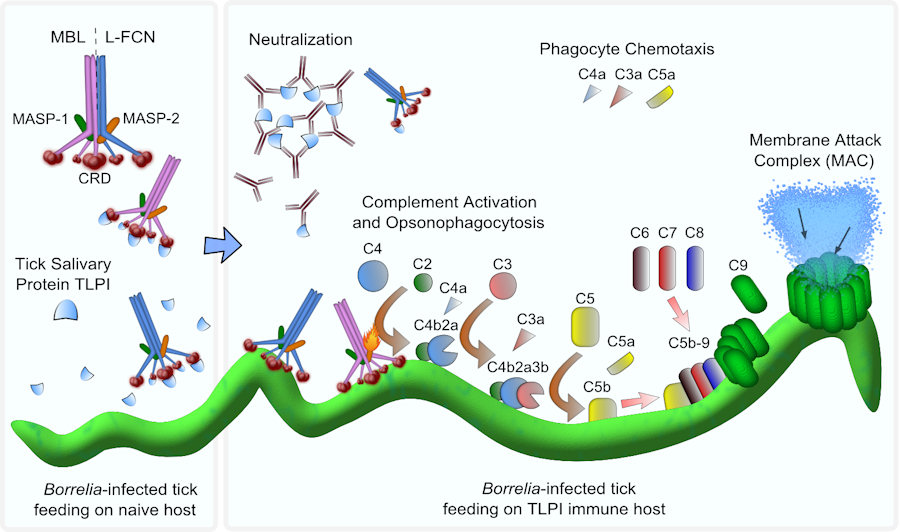
Artist impression of the complement lectin route in action with a spirochete resulting in a hole in the cell membrane and the release of
chemotactic substances to attract white blood cells.
The complement system is a bunch of approximately 30 proteins that can inhibit or activate other protein in this system. There are three pathways to start the system. They are named the classical, the alternative and the lectin route. All three converge to the final pathway at C3 resulting in the assemblage of C5-C9 membrane attack complex (MAC)
If this system is activated the cascade of interactions start and one protein cuts off a part of an other protein that become an
enzyme and then can split a part of the next protein that in turn also becomes an enzyme resulting in a cascade of reactions.
In the case of the lectin route. MBL (mannose binding lectin) binds to specific sugar groups on the surface of the bacterium. The protein gets deformed and can bind a protein group called MASP (
Mannose-binding lectin Associated Serine Protease). This combination becomes an enzyme that is able to split C4 in two fragments C4a and C4b. The C4a is able to cut off a part from C2 and so on. In the end C9 get activated and this activated protein combines with other activated C9 proteins and forms a tunnel penetrating the surface of the bacterium. The bacterium start to leaks its internal fluids en dies. When this system is activated small fragments C4a, C3a and C5a are released. These particles attract the white blood cells and they are actively moving (chemotaxis) to the infection. These cells kill the bacterium and present parts of the bacterium to the immune system so it can make antibodies.
A balance between activation and inhibitions keeps the complement system in pace.
The tick's saliva contains proteins that inhibit this lectin route activation. Borrelia is not killed instantly and is able to enter the body.
About 10% of the Caucasians are MBL-deficient, meaning they have no active MBL and no activation of the complement system by this route. Luckily for them the body has many other defense systems but this first line of defense is crippled and MBL-deficient people may be more prone to get Lyme disease.

The coagulation cascade is also an very complex and advanced system in which many proteins are involved. When tissue is damaged collagen is exposed to circulating platelets in the blood. These platelets binds firmly to the collagen and form a plug at the site of injury. Simultaneously the coagulation cascade starts forming fibrin strands which strengthens the platelet plug. The blood clotting cascade is initiated by a protein named tissue factor (TF). TF activates FVII that in turn activates factor X turning prothrombin (Factor II) into thrombin that in turn activates fibrinogen into fibrin. The whole coagulation system is regulated by many other proteins. The tick's saliva contains a variety of molecules that all together inhibits the sophisticated coagulation system resulting is a fluid blood meal for the tick.
Identifying the tick proteins that inhibits the defense system is crucial in developing
vaccines. When the body has made antibodies to one of the tick's saliva proteins the tick can not engorged and will be killed by the immune system. Being bitten by a not infected tick is probably
beneficial. The body is able to make antibodies to the tick's saliva proteins and will protect us for the second bite.
But who will take the risk of letting the tick sit there for two weeks?
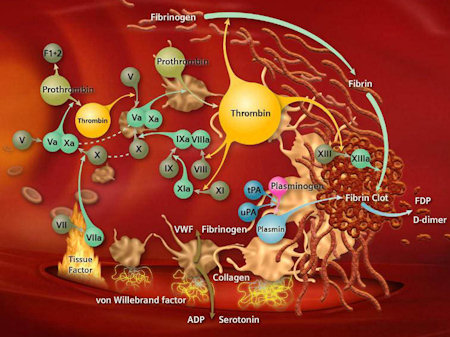
Picture: http://healthcare.siemens.com/hemostasis/